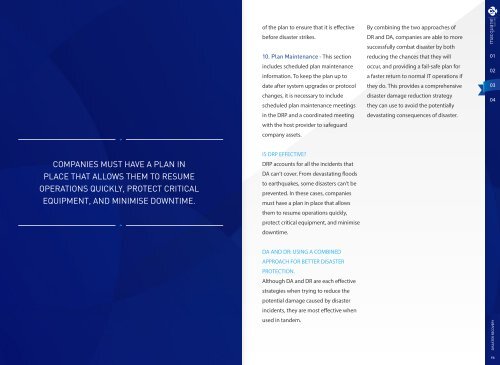DISASTER AVOIDANCE DISASTER RECOVERY
You also want an ePaper? Increase the reach of your titles
YUMPU automatically turns print PDFs into web optimized ePapers that Google loves.
of the plan to ensure that it is effective<br />
before disaster strikes.<br />
10. Plan Maintenance - This section<br />
includes scheduled plan maintenance<br />
information. To keep the plan up to<br />
date after system upgrades or protocol<br />
changes, it is necessary to include<br />
scheduled plan maintenance meetings<br />
in the DRP and a coordinated meeting<br />
with the host provider to safeguard<br />
company assets.<br />
By combining the two approaches of<br />
DR and DA, companies are able to more<br />
successfully combat disaster by both<br />
reducing the chances that they will<br />
occur, and providing a fail-safe plan for<br />
a faster return to normal IT operations if<br />
they do. This provides a comprehensive<br />
disaster damage reduction strategy<br />
they can use to avoid the potentially<br />
devastating consequences of disaster.<br />
01<br />
02<br />
03<br />
04<br />
COMPANIES MUST HAVE A PLAN IN<br />
PLACE THAT ALLOWS THEM TO RESUME<br />
OPERATIONS QUICKLY, PROTECT CRITICAL<br />
EQUIPMENT, AND MINIMISE DOWNTIME.<br />
IS DRP EFFECTIVE?<br />
DRP accounts for all the incidents that<br />
DA can’t cover. From devastating floods<br />
to earthquakes, some disasters can’t be<br />
prevented. In these cases, companies<br />
must have a plan in place that allows<br />
them to resume operations quickly,<br />
protect critical equipment, and minimise<br />
downtime.<br />
DA AND DR: USING A COMBINED<br />
APPROACH FOR BETTER <strong>DISASTER</strong><br />
PROTECTION.<br />
Although DA and DR are each effective<br />
strategies when trying to reduce the<br />
potential damage caused by disaster<br />
incidents, they are most effective when<br />
used in tandem.<br />
<strong>DISASTER</strong> <strong>RECOVERY</strong><br />
P8



